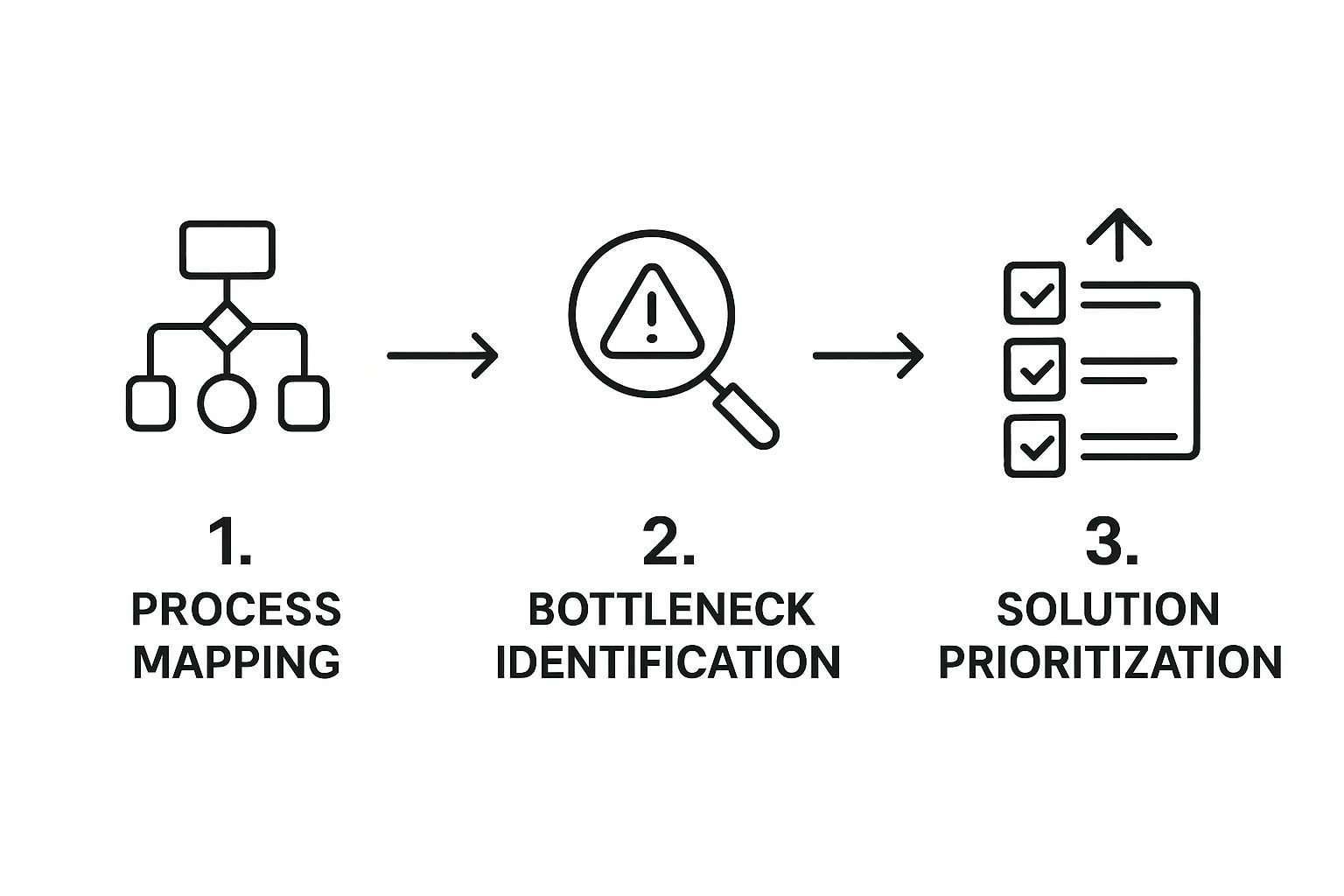In any competitive market, we all talk about being more efficient. But what does that actually mean in practice? At its core, it’s about taking a hard, honest look at how your business runs day-to-day. Business process optimization is the methodical approach to improving your workflows to cut costs, boost efficiency, and ultimately, keep your customers happy. It’s about analysing, redesigning, and monitoring your core operations to eliminate waste and deliver better results.
Why Process Optimization Is No Longer Optional

In a market that moves at lightning speed, clunky, inefficient workflows aren't just minor headaches—they're a serious liability. Any slow, clumsy, or outdated process can directly hit your bottom line, frustrate your customers, and hand your competitors an advantage. Fixing this is what business process optimization is all about.
Forget the corporate jargon for a moment. Think of it as a proper health check for your operations. You meticulously examine how work gets from A to B, hunting for hidden bottlenecks, wasted resources, and opportunities to dramatically improve how you serve your customers.
From Theory to Reality
Let's look at some real-world examples. Imagine a small e-commerce shop constantly battling supply chain delays because of a chaotic ordering system. Or picture a freelance consultant whose slow client response times are losing them business because every query—urgent or not—lands in a single, cluttered inbox.
These aren't just small hiccups. They're critical failures that can ruin a company's reputation and stop growth in its tracks. Effective business process optimization gets right to the root of these problems and solves them.
For businesses here in the UK, this has become a huge priority, especially with ongoing tech shifts and customers who expect more than ever. Many have been forced to redesign supply chain workflows to navigate constant delays—a problem that hits both productivity and client happiness hard. As a result, consulting work is now focused on bringing in automation and real-time data to spot issues early and stay compliant. You can find out more about how UK firms are tackling these challenges in this 2025 guide on business process consulting.
The core idea is simple: if a process is costing you time, money, or customer goodwill, it needs fixing. Ignoring it isn't just bad for growth; it's a threat to survival.
The Real-World Impact of Smarter Processes
When you finally sort out your workflows, you see tangible benefits that you can actually measure. This isn't just about feeling more organised; it’s about achieving real results that build a healthier business and a stronger position in the market.
Before we dive into the 'how', let's quickly compare the before and after. The difference between a manual, clunky process and an optimised one is night and day.
Manual vs Optimized Process Outcomes
| Business Area | Typical Manual Process Issue | Optimized Process Outcome |
|---|---|---|
| Customer Support | Slow response times, lost tickets, inconsistent answers. | Instant automated replies, faster resolutions, happier customers. |
| Sales & Quoting | Delays in sending quotes, manual follow-ups, lost leads. | Automated quote generation, systematic follow-ups, higher conversion rates. |
| Inventory | Stockouts or overstocking due to poor tracking. | Real-time stock levels, automated re-ordering, reduced holding costs. |
| Onboarding | Inconsistent new client/employee experience, manual paperwork. | Standardised digital workflow, faster setup, better first impression. |
As you can see, the improvements touch every part of the business, creating a ripple effect that leads to significant gains.
So, what are the key benefits you can expect?
- Reduced Operational Costs: By cutting out redundant steps and automating repetitive jobs, you spend less on wasted time, labour, and materials.
- Improved Customer Satisfaction: Faster responses, fewer mistakes, and consistent service lead directly to happier clients who stick around and recommend you.
- Increased Productivity: When your team has a clear and efficient way of working, they get more done in less time. This frees them up for more important, high-value tasks.
- Enhanced Agility: A well-oiled business can react much faster to market changes, new technology, or any unexpected curveballs that come your way.
How to Find Hidden Inefficiencies in Your Workflows
You can't fix a problem you don't fully understand. The first step in making your business run better is to get an honest, unfiltered look at how things actually work—not how you think they work on paper. This means digging in and mapping out your current processes to find the cracks.
Forget complex management theories for a moment. Finding what’s holding you back often comes down to two simple things: drawing out your workflow and, crucially, talking to your team. They’re the ones on the front lines, wrestling with frustrating bottlenecks and pointless tasks every day. Their insights are pure gold.
Visualise Your Workflow
Process mapping sounds more complicated than it is. At its heart, it’s just about creating a flowchart of a task from start to finish. I always recommend grabbing a whiteboard, a stack of sticky notes, or even just a large piece of paper to get started.
Let's take a common example: map the entire journey from the moment a customer places an order to when it's dispatched. Track every single action, every person who touches it, and every decision that gets made along the way. This simple act of making the process visible almost always reveals glaring issues you never saw before.
The real aim here is to create an "as-is" snapshot of your workflow. This baseline is critical. It forces you to confront reality, which makes it much easier to spot the changes that will give you the biggest bang for your buck.
This diagram breaks down the core stages of figuring out where the problems lie.

As you can see, it's a clear path: start by mapping what you do now, find the sticking points, and then decide which solutions to tackle first. This is the foundation of any optimisation project that actually works.
Ask the Right Questions
Once you have that visual map, it’s time to bring your team in and start poking holes in it. This isn't about placing blame; it's about collaboration. I’ve seen time and again that getting your employees involved leads to far better, more sustainable improvements.
Gather everyone around the map and start asking some pointed questions.
- Where do things grind to a halt? Pinpoint the exact moments where work gets stuck. Is it always waiting for an approval? Is key information constantly missing?
- Which steps feel pointless or repetitive? Hunt for tasks that are done twice or simply add no real value. A classic one is having to manually type the same customer details into three different systems.
- Where does communication fall apart? This is a big one. Identify where miscommunication leads to mistakes or delays, especially when work is handed over between people or departments.
- What tasks drive the team crazy? Pay close attention to morale. The jobs your staff complain about the most are almost always the most inefficient ones.
Uncovering these hidden drains on your time and money is the most important part of this whole exercise. By asking these questions, you’re no longer guessing. You're getting to the root causes, which means you can focus your energy on changes that will genuinely make your business run smoother, faster, and more profitably.
Using Technology to Build Smarter Workflows

So, you’ve mapped out your workflows and found the weak spots. What now? While some fixes might be simple process tweaks, technology is often where you’ll find the biggest gains. The right tools can take tedious jobs off your team’s plate, give you a much clearer picture of performance, and ultimately help everyone work smarter.
This is what business process optimisation is all about. It’s not about chasing every new, shiny piece of software. It’s about being strategic and picking technology that solves a real problem you've already identified.
Think about it this way: if your team is drowning in manual data entry, spending hours copying customer details between systems, a simple automation tool could handle that in seconds. Not only does that free up their time, but it also gets rid of those inevitable, costly typos. That’s a practical change with an immediate impact.
The Rise of Automation and AI
Modern Business Process Management (BPM) software has come a long way from being a simple digital to-do list. Today, these platforms are packed with powerful automation and intelligence, making them one of the best assets for building better workflows.
This isn't just a niche trend; it’s taking hold across the UK. The BPM market is now heavily shaped by tools like Robotic Process Automation (RPA), Artificial Intelligence (AI), and Machine Learning (ML). In fact, as of early 2025, an estimated 39% of UK companies are specifically embedding AI-driven automation into their process strategies. It helps them slash manual work, get ahead of potential bottlenecks, and smooth out the way different departments work together. You can dive deeper into the UK BPM market and its technological drivers here.
The point of using technology isn't just to do the same old tasks a bit faster. It’s to fundamentally rethink how the work gets done, creating processes that are more reliable, efficient, and resilient.
So, how do you actually apply this without feeling overwhelmed? I always advise starting with tools that give you the most immediate and obvious benefits.
- Automation Platforms: These are brilliant for handling repetitive, rule-based tasks. Imagine automatically sending follow-up emails, generating invoices, or updating spreadsheets without anyone having to lift a finger.
- Integrated Communication Tools: Something as simple as a dedicated number for WhatsApp Business can be a game-changer. It cleanly separates work from personal messages, letting you set up automated replies and manage client queries in a far more organised way. Your response times will thank you for it.
- Project Management Software: Tools like Asana, Trello, or Monday.com create a central hub for tasks, deadlines, and team chat. Everyone knows exactly who is doing what, and when it’s due.
Choosing the Right Tech for Your Business
Looking at all the tools out there can feel like a mammoth task. The secret is to start small and focus on your single biggest headache. Please don’t try to roll out a massive, all-in-one system overnight; that's a recipe for disaster.
Instead, just ask yourself this one question: What is the one problem that, if solved, would make the biggest positive difference to my business right now?
If the answer is chaotic customer communication, a service like Business Numbers Direct offers a straightforward, low-cost way to get a dedicated WhatsApp Business number. If it’s messy project handovers causing delays, a basic project management board could be all you need.
By choosing technology to fix a specific, known inefficiency, you ensure you get a real return on your investment. More importantly, you build the momentum and confidence to tackle the next improvement.
Using WhatsApp to Sharpen Your Customer Communication
Let’s be honest, disorganised communication is a real process killer. When customer messages get buried, replies lag, and your team is stuck repeating the same answers, it’s not just bad service—it’s a direct hit to your business’s efficiency. The good news? This is one of the most straightforward areas of business process optimisation to fix.
One of the most powerful tools for this job is probably already in your pocket. Getting a dedicated WhatsApp Business number can completely change the game for customer interaction. The first win is simple but profound: it neatly separates your work life from your personal one. No more client chats tangled up with messages from your mum. This one move brings focus and professionalism to your replies and adds a much-needed layer of order to your day.
Automate Your Way to Better Service
Once you have a dedicated number, you unlock a suite of features built for business. Think about the questions you answer all the time. What are your opening hours? Where are you located? What’s your return policy? Instead of typing out the same reply endlessly, you can set up automated responses.
For example, I know a local handyman who sets an "away message" for any enquiries that come in after 6 pm. It automatically replies with his business hours and a link to his online booking page. This simple step gives the customer an immediate, helpful response and saves the handyman from replying late at night. It’s a small tweak that massively improves the customer experience.
Proactive Updates and Quick Replies
Another brilliant feature for improving your processes is the broadcast list. This isn't a group chat where everyone sees everyone else's replies (and the ensuing notification chaos). Instead, it lets you send one message to many contacts individually. It’s perfect for getting ahead of problems.
- Online Shops: A store can send a broadcast to customers about a shipping delay, preventing a flood of "Where is my order?" messages.
- Consultants: A freelancer can inform all their clients about upcoming holiday dates in one go, managing expectations effortlessly.
- Local Cafes: A cafe can send its weekly specials to a list of regulars, sparking orders without any manual effort.
On top of that, Quick Replies are an absolute lifesaver when you're dealing with lots of messages. This feature lets you save and reuse messages you send all the time. By just typing a shortcut like "/thanks," you can instantly send a pre-written thank-you message, perhaps with a link to leave a review.
Setting up a dedicated business line isn't just about looking more professional. It’s a strategic move to reclaim valuable time, reduce errors, and build a communication system that works for you, not against you.
By investing in a low-cost solution like a dedicated virtual number for WhatsApp from a provider like Business Numbers Direct, you can get these powerful automations up and running in minutes. This is a classic example of business process optimisation that delivers immediate, tangible results, giving your team back precious time and making your customers happier.
How to Measure Success and Maintain Momentum

So, you’ve put in the hard work and rolled out your shiny new workflows. Great! But the job isn't done. In fact, this is where the real work begins. Business process optimisation is never a one-and-done task; it’s an ongoing cycle of refining and improving.
To keep that initial momentum from fizzling out, you have to measure what’s actually working. You need to see the real-world impact of your changes and, just as importantly, build a culture where everyone is on board with finding better ways to do things. Simply put, if you don't measure your progress, you can't manage it.
Tracking the Right Metrics
It’s easy to get lost in an ocean of data. The key is to focus on a handful of Key Performance Indicators (KPIs) that genuinely tell you whether your processes are getting healthier. These metrics should tie directly back to your original goals, whether that was to save time, reduce costs, or simply make your customers happier.
Here are a few essential KPIs I always recommend starting with:
- Cycle Time: This is the total time it takes for a process to run its course, from the very first step to the last. For instance, how long does it take from the moment a customer sends a WhatsApp query until their issue is completely resolved? A shorter cycle time is a crystal-clear sign of better efficiency.
- Cost Per Transaction: Work out the total cost of running a process—factoring in staff time, software, and any other resources—and divide it by the number of times you complete it. If this number is dropping, your optimisations are directly helping your bottom line.
- Error Rate: Keep an eye on how often mistakes happen or work needs to be redone. A falling error rate proves that your new, standardised workflow is more reliable and delivering more consistent results.
The real magic happens when you mix hard data with human feedback. The numbers tell you what is happening, but it’s your team and your customers who can tell you why.
Building a Culture of Continuous Improvement
Data is vital, but lasting change is driven by people. To keep things moving in the right direction, you need to embed business process optimisation into your company’s DNA. This means creating a system where your team feels comfortable and empowered to flag what isn't working and suggest improvements.
This is becoming a non-negotiable for UK businesses that want to stay ahead. The UK's Business Process Management market is predicted to grow at a compound annual growth rate (CAGR) of 20.7% between 2025 and 2030. This boom is happening because more companies are finally embracing automation and smarter process modelling to get more efficient and enhance their customer experience. You can read more about how UK businesses are gaining an edge in the full Grand View Research market analysis.
How do you create this culture? Start by scheduling regular, informal process check-ins. These aren't stuffy meetings for pointing fingers. They're quick, collaborative chats—maybe monthly or quarterly—to ask simple but powerful questions like, "What's still a pain point?" or "Is there anything we could do to make this even smoother?"
Finally, celebrate the wins. When you successfully slash your customer response times or kill off a universally hated manual task, make sure everyone knows about it. Acknowledging these successes reinforces the value of everyone's effort and keeps the team motivated for the next challenge.
Got Questions About Business Process Optimisation?
As you start looking at ways to improve your business operations, it's completely normal for a few questions to pop up. In fact, asking the right questions is the first step. Getting clear, straightforward answers can be the difference between a project that flies and one that never gets off the ground. Let's tackle some of the most common ones I hear from business owners.
What’s the Very First Thing I Should Do?
Before you change a single thing, you need to map out your current process. And I mean exactly as it is right now—warts and all—not how you think it’s supposed to run.
Get a big sheet of paper or a whiteboard and trace the journey of a task from its very beginning to the end. Who does what? Which tools are used? Where are the decision points? This creates an honest "as-is" baseline. You'll be surprised at what you find. This simple exercise almost always shines a spotlight on obvious delays, communication breakdowns, and tasks that are being needlessly repeated.
Trying to improve a process without this map is like trying to find your way in a new city without directions. You'll waste a lot of time and energy fixing symptoms instead of the real problems.
How Can Small Businesses Do This Without a Big Budget?
You absolutely do not need a massive budget to make a real difference. For smaller businesses, the secret is to focus on high-impact changes that don't cost a fortune. A brilliant place to start is customer communication.
For instance, getting a dedicated WhatsApp Business number is a quick, low-cost win. It immediately separates your personal and professional messages, makes your business look more established, and opens the door to simple automation. Another easy fix is creating standard checklists for common tasks to cut down on mistakes. The key is to find your single biggest pain point—the one that causes the most headaches—and focus all your energy there first.
Many small businesses I've worked with achieved their biggest initial wins just by sorting out their customer communication. It's often the area with the most to gain for the least amount of investment.
How Do I Get My Team on Board with These Changes?
This is a big one. If your team isn't on board, even the best-laid plans will fail. The trick is to involve them from the very beginning instead of just handing down new rules from on high.
Here’s what I’ve found works best:
- Make Them Part of the Process: When you're mapping out the "as-is" process, get the people who actually do the work involved. They know the reality of the day-to-day and can pinpoint the real frustrations better than anyone.
- Show Them "What's In It for Me?": Frame the changes around how their jobs will become easier. Talk about getting rid of boring, repetitive tasks or eliminating frustrating bottlenecks that slow them down.
- Listen, Really Listen: When people feel like their feedback is genuinely valued and they understand the 'why' behind a change, they're much more likely to support it. They might even become your biggest advocates.
How Often Should We Review Our Processes?
Think of it in two ways. For your core, most critical business processes, a deep-dive review at least once a year is a good rule of thumb. You should also revisit them anytime something major happens, like bringing in new software or a big shift in your market.
But don't just wait for the annual review. Great process improvement is a continuous habit, not a one-off event. Encourage your team to have smaller, more frequent check-ins—maybe quarterly or even monthly—to chat about what's working and what isn't. This agile approach helps you make small adjustments on the fly, stopping little issues from turning into major headaches.
Ready to take that first simple step toward better customer communication? With Business Numbers Direct, you can get a dedicated virtual number for WhatsApp Business set up in under five minutes, all for just £7.99 a month. Separate your work and personal life and start automating replies today. Get your professional WhatsApp number now.




